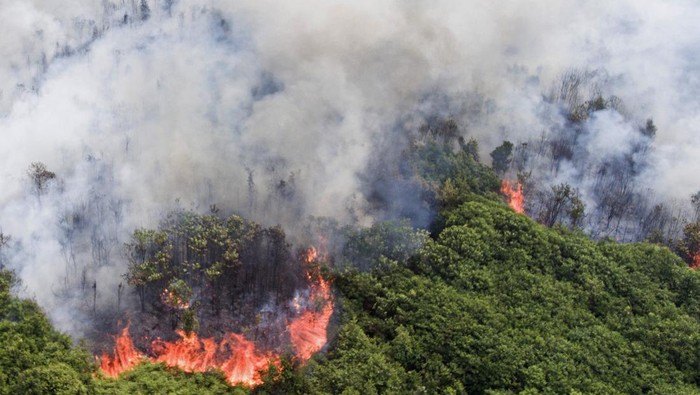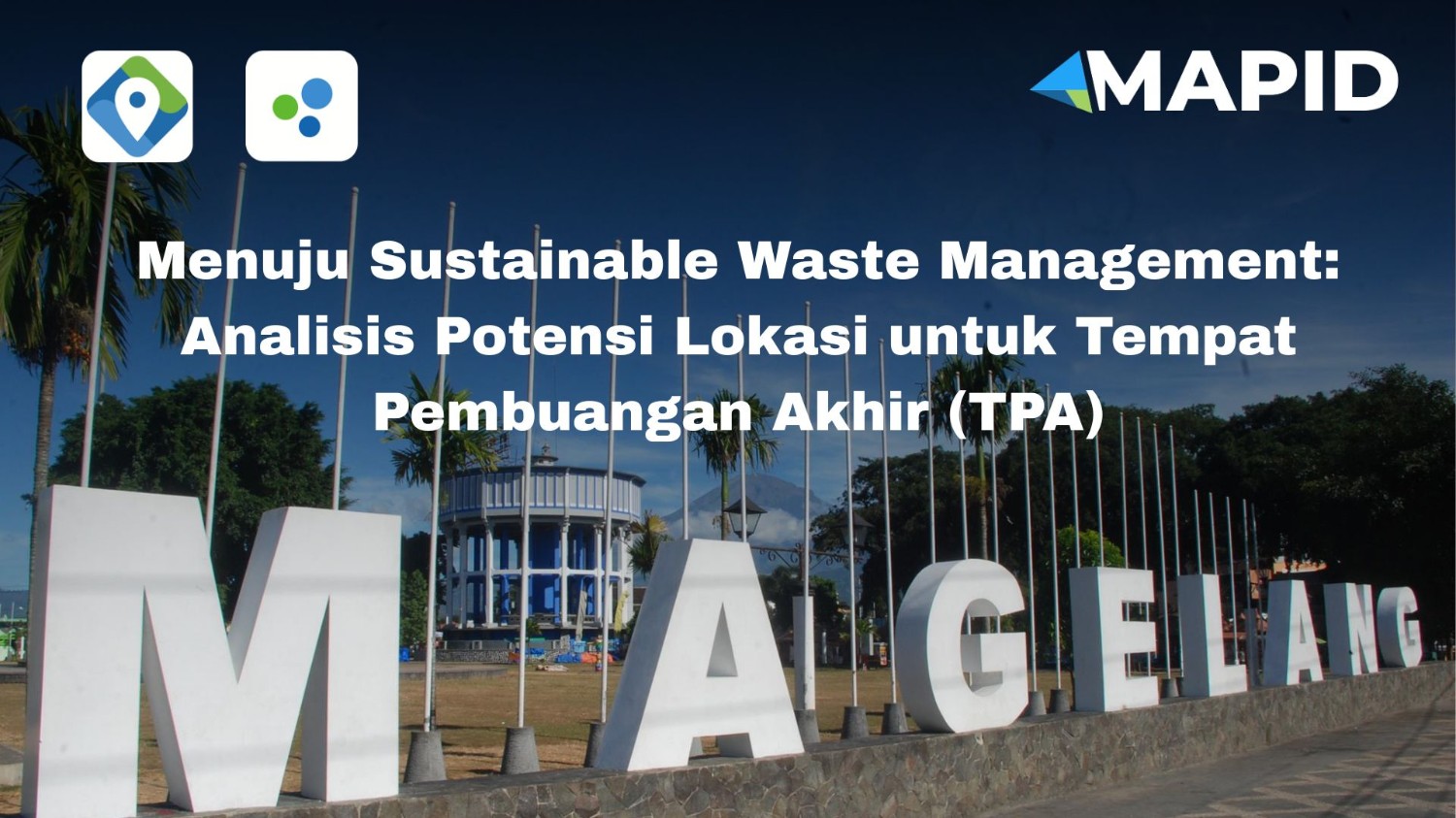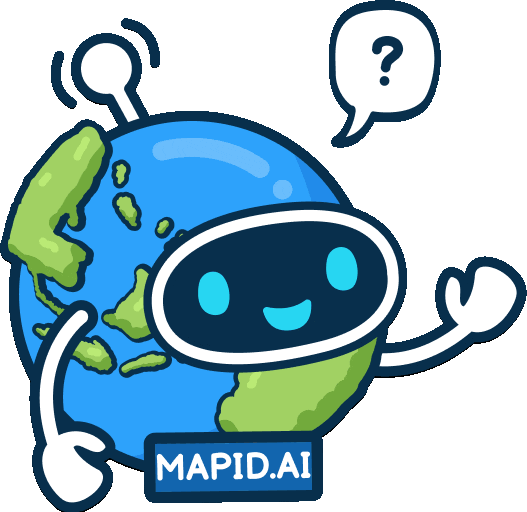Pada GEODATA edisi sebelumnya, MAPID telah membahas gempa bumi. Ada penjelasan yang disebut tsunami adalah apabila jalur pertemuan lempeng berada di laut yang mengakibatkan gempa bumi besar dengan kedalaman dangkal. Tsunami sendiri juga merupakan salah satu dampak dari peristiwa gempa bumi.
In the previous GEODATA edition, MAPID talked about the earthquake. There was an explanation about something that can be called a tsunami if the plate meeting point is in the sea resulting in a large earthquake with shallow depths. Tsunami itself is one of the impacts resulting from an earthquake disaster.
Definisi
Tsunami berasal dari bahasa Jepang yaitu 'Tsu' yang artinya pelabuhan dan 'Nami' yang artinya gelombang laut. Awalnya istilah ini muncul bermakna gelombang laut yang menghantam pelabuhan. Tsunami dapat bergerak dengan kecepatan hingga lebih dari 900 km per jam dan dapat mencapai daratan dengan ketinggian gelombang hingga 30 meter. Meskipun tidak terlalu merusak garis pantai, tsunami sangat berpotensi bahayanya.
Tsunami comes from the Japanese word 'Tsu' which means harbor and 'Nami' which means sea wave. Initially, this term appeared to mean sea waves that hit the harbor. Tsunamis can travel at speeds of up to more than 900 km per hour and can reach land with wave heights of up to 30 meters. Although not too damaging to the coastline, tsunamis are potentially very dangerous.
Area yang memiliki risiko tinggi jika gempa bumi besar atau tanah longsor terjadi dekat pantai gelombang pertama dalam seri bisa mencapai pantai dalam beberapa menit, bahkan sebelum peringatan dikeluarkan. Area berada pada risiko yang lebih besar jika berlokasi kurang dari 25 meter di atas permukaan laut dan dalam beberapa meter dari garis pantai.
In areas of high risk if a major earthquake or landslide occurs near the coast the first wave in a series can reach the beach within minutes, even before a warning is issued. Areas are at greater risk if they are located less than 25 meters above sea level and within a few meters of the shoreline. ��
Proses Terjadinya Tsunami
Proses terjadinya tsunami dimulai dengan gempa bumi yang membuat dasar laut merekah. Kemudian, air laut akan masuk mengisi lubang rekahan tersebut sehingga terjadi surut air laut di pesisir pantai. Lubang yang berada di tengah laut tersebut terisi penuh lalu menyemburkan kelebihan air yang dimiliki ke segala arah termasuk pantai. Akibatnya, terjadi gelombang yang sangat besar yang menerpa pantai dan dapat mencapai daratan sejauh 5 km. Guncangan dari dasar laut ini mengguncang air yang ada di atasnya sehingga gelombang tsunami akan semakin besar ketika mendekati pantai.
The process of occurrence of a tsunami begins with an earthquake that causes the ocean floor to crack. Then, seawater will enter to fill the fracture hole so that seawater recedes on the coast. The hole in the middle of the sea is filled and then ejects excess water in all directions, including the beach. The result is exceptionally huge waves that strike the coast and can travel up to 5 kilometers inland. This shock from the seabed shakes the water above it so that the tsunami waves will get bigger as they approach the coast.
Tsunami datang dalam bentuk gelombang air laut besar yang dipicu oleh pusaran air bawah laut karena pergeseran lempeng, tanah longsor, erupsi gunung api, dan jatuhnya meteor. Tsunami yang terjadi akibat gempa bumi mempunyai ciri-ciri pusat gempa bumi terletak di dasar laut dan kedalaman pusat gempanya kurang dari 60 km. Tsunami akibat letusan gunung api dapat mengakibatkan naiknya gelombang air laut yang besaran kekuatan getaran berantung pada gunung apinya.
Tsunamis come as large sea waves triggered by underwater eddies due to plate shifts, landslides, volcanic eruptions, and falling meteors. Tsunamis that occur due to earthquakes have the characteristics of the earthquake epicenter located on the seabed and the depth of the epicenter is less than 60 km. Tsunamis caused by volcanic eruptions can cause rising sea waves whose magnitude of vibration strength depends on the volcano.
Selanjutnya, tsunami yang disebabkan oleh longsor yang terjadi di dasar laut disebut tsunami longsor bawah laut. Gempa bumi tektonik, letusan gunung berapi, getaran kuat tanah longsor bawah laut, dan tumbukan lempeng bawah laut adalah penyebab tsunami ini. Tsunami yang disebabkan oleh jatuhnya meteor jarang terjadi. Sayangnya, belum ada dokumentasi mengenai hal ini. Namun, hasil simulasi dengan komputer canggih menunjukkan efek yang mirip seperti ketika benda berat menghantam air di kolam atau bak mandi.
Next, a tsunami caused by a landslide that occurs on the seabed is called a tsunami submarine landslide. Tectonic earthquakes, seamount eruptions, strong vibrations undersea landslides, and undersea plate collisions are the causes of this tsunami. Tsunamis due to falling meteors rarely occur. Unfortunately, there is still no documentation of it. However, the simulation results with advanced computers show an effect that is similar to when a heavy object hits the water in a pond or tub.
Jenis-Jenis Tsunami
1. Tsunami Jarak Dekat (Lokal)
Tsunami jenis ini terjadi 0-30 menit setelah sebuah gempa bumi terjadi. Jarak pusat gempa ke lokasinya sejauh 200 km. Daerah di sekitar gempa bumi kemungkinan besar dapat merasakan tsunami dan merusak bangunan. Sistem peralatan yang digunakan untuk mendeteksinya adalah alarm.
TypeTypes of Tsunamis
1. Close Range (Local) Tsunami
This type of tsunami occurs 0-30 minutes after an earthquake occurs. The distance from the epicenter to the location is 200 km. The area around an earthquake is likely to feel a tsunami and damage buildings. The equipment system used to detect it is an alarm.
2. Tsunami Jarak Menengah
Setelah suatu gempa bumi terjadi, sekitar 30 menit-2 jam adalah waktu kemungkinan tsunami ini terjadi dengan jarak pusat gempa ke lokasi sejauh 200-1000 km. Ada kemungkinan bahwa daereah di sekitar jarak ini ikut merasakan gempa dengan intensitas II sampai V MMI (Modified Mercalli Intensity). Sistem peralatan yang digunakan untuk mendeteksinya adalah alarm.
2. Medium Range Tsunami
After an earthquake occurs, about 30 minutes-2 hours is the time this tsunami is likely to occur with the distance from the epicenter to the location as far as 200-1000 km. The area around this distance may also feel the earthquake with intensities II to V MMI (Modified Mercalli Intensity). The equipment system used to detect it is an alarm.
3. Tsunami Jarak Jauh
Terjadi lebih dari dua jam setelah gempa bumi terjadi dengan jarak lebih dari 1000 km dari pusat gempa. Sangat kecil kemungkinan untuk daerah di sekitar merasakan gempa namun masih mungkin terjadi pasang surut air laut sebelum gelombang tsunami ini datang. Sistem peralatan yang digunakan adalah Tremors yang sudah dipasang di Stasiun Geofisika terdekat.
3. Remote Tsunami
Occurred more than two hours after the earthquake occurred at a distance of more than 1000 km from the epicenter. It is very unlikely that the area around it will feel the earthquake, but it is still possible for sea tides to occur before the tsunami waves arrive. The equipment system used is Tremors which has been installed at the nearest Geophysics Station.
Faktor-Faktor yang Memengaruhi Tinggi Tsunami
a. Bentuk Pantai
Transformasi gelombang akibat adanya perubahan geometri dasar laut disebabkan refraksi. Di tempat di mana terjadi penyempitan, maka akan terjadi konsentrasi energi sehingga tinggi gelombang di tempat tersebut akan membesar.
FactFactors Affecting Tsunami Height
a. Beach Shape
Wave transformations due to changes in the geometry of the seabed are caused by refraction. There will be a concentration of energy where there is constriction. It will cause the wave height there to rise.
b. Kelandaian Pantai
Jarak jangkauan tsunami ke daratan juga sangat ditentukan oleh terjal dan landainya morfologi pantai. Di mana pada pantai terjal, tsunami tak akan terlalu jauh mencapai daratan akibat tertahan dan dipantulkan kembali oleh tebing pantai. Sementara di pantai landai, tsunami akan menerjang sampai beberapa kilometer masuk ke daratan.
b. Beach Slope
The steepness and mild slope of the shore both affect the tsunami's ability to reach land. Where on a steep coast, the tsunami will not reach the mainland too far because it is stopped and reflected by the coastal cliffs. While on the sloping coast, the tsunami will hit up to several kilometers inland.
c. Vegetasi dan Struktur Penghalang di Sekitar Pantai
Semakin tebal suatu hutan, maka semakin terbukti kemampuannya dalam meredam tsunami. Besaran run up dan tinggi genangan akan berkurang sehingga menurunkan besaran arus.
c. Vegetation and Barrier Structures Around the Beach
The thicker a forest, the more proven its ability to absorb tsunamis. The amount of run-up and the height of the puddle will be reduced thereby reducing the amount of current.
d. Arah Gelombang Tsunami
Gelombang tsunami yang datang dengan arah tegak lurus dengan pantai tentu akan menyebabkan tinggi gelombang tsunami lebih tinggi jika dibandingkan tinggi gelombang tsunami yang datang dengan arah sejajar menurut mata angin atau dengan sudut tertentu.
d. Tsunami Wave Direction
Tsunami waves coming in a direction perpendicular to the coast will of course cause a higher tsunami wave height compared to the incoming tsunami wave heights parallel to the cardinal points or at a certain angle.
e. Efek Pemantulan dari Pulau Lain
Gelombang tsunami yang terjadi tidak langsung berasal dari sumbernya, melainkan akibat adanya pemantulan gelombang dari pulau sekitar yang terkena dampak tsunami.
e. Reflection Effect from Other Island
The tsunami waves that occurred did not come directly from the source but were the result of the reflection of the waves from the surrounding islands that were affected by the tsunami.
Hantaman gelombang tsunami bisa masuk hingga puluhan kilometer dari bibir pantai. Kerusakan dan korban jiwa yang terjadi karena tsunami bisa diakibatkan karena hantaman air maupun material yang terbawa oleh aliran gelombang tsunami. Dampak negatif tsunami yaitu merusak apa saja yang dilaluinya. Bangunan, tumbuh-tumbuhan, korban jiwa manusia serta menyebabkan genangan, pencemaran air asin lahan pertanian, pencemaran tanah, dan pencemaran air bersih.
Tsunami waves can enter up to tens of kilometers from the shoreline. The damage and casualties that occurred due to the tsunami could be caused by the impact of water or material carried by the tsunami wave flow. The negative impact of the tsunami is that it destroys everything in its path. Buildings, plants, human casualties as well as causing inundation, salt water pollution of agricultural land, soil pollution, and clean water pollution.
Indonesia memiliki 21 wilayah rawan tsunami yang meliputi Nanggroe Aceh Darussalam, Sumatera Utara, Sumatera Barat, Bengkulu, Lampung-Banten, Jawa Tengah bagian selatan, Jawa Timur bagian selatan, Bali, Nusa Tenggara Barat, Nusa Tenggara Timur, Sulawesi Utara, Sulawesi Tengah, Sulawesi Selatan, Maluku Utara, Maluku Selatan, Biak-Yapen, Balikpapan, Sekurau, Palu, Talaud, dan Kendari.
Indonesia has 21 tsunami-prone areas which include Nanggroe Aceh Darussalam, North Sumatra, West Sumatra, Bengkulu, Lampung-Banten, the southern part of Central Java, the southern part of East Java, Bali, West Nusa Tenggara, East Nusa Tenggara, North Sulawesi, Central Sulawesi, South Sulawesi, North Maluku, South Maluku, Biak-Yapen, Balikpapan, Sekurau, Palu, Talaud and Kendari.
MAPID saat ini sudah memiliki data potensi bahaya/ancaman bahaya tsunami dan sudah mencakup seluruh wilayah Indonesia. Dengan menggunakan data potensi bahaya bencana tsunami yang tersedia di GEO MAPID, para pengguna platform dapat memahami risiko dan dampak dari ancaman tsunami dalam membuat keputusan berbasis lokasi. Misalnya, bagi seorang pengusaha yang ingin membuka usaha restoran, atau seorang individu yang ingin mencari tempat hunian, mereka dapat mempertimbangkan lokasi yang aman dari ancaman bencana tsunami.
MAPID currently has data on potential tsunami hazards/threats and covers all areas of Indonesia. By using the potential tsunami disaster hazard data available in GEO MAPID, platform users can understand the risk and impact of the tsunami threat in making location-based decisions. For example, an entrepreneur who wants to open a restaurant business, or an individual who wants to find a place to live, can consider a location that is safe from the threat of a tsunami disaster.
![[GEODATA] Potensi Bahaya Tsunami](https://mapidstorage.s3.ap-southeast-1.amazonaws.com/general_image/mapidseeit/1675998154013_Screenshot_4.jpg.jpeg)
Pengguna juga dapat menggabungkan data potensi bahaya tsunami dengan fitur location profiling yang tersedia di GEO MAPID seperti SINI. Fitur SINI memungkinkan mereka untuk mengetahui demografi penduduk, seperti jumlah dan kepadatan penduduk, profesi, tingkat pendapatan, pendidikan, penggunaan lahan, dan harga tanah. Selain itu, SINI juga menyediakan��Point of Interest (POI) dari fasilitas-fasilitas umum mulai dari sekolah, mall, kantor pemerintahan hingga lokasi evakuasi bencana. Hal ini berguna bagi para pengguna dalam mempertimbangkan faktor-faktor lain yang mempengaruhi pemilihan lokasi, seperti tingkat kenyamanan dan fasilitas yang tersedia, sehingga bisa berkontribusi dalam ketepatan keputusan yang dibuat oleh pengguna GEO MAPID.
Users can also combine potential tsunami hazard data with location profiling features available in GEO MAPID such as HERE. The SINI feature allows them to find out the demographics of the population. Such as population size and density, profession, income level, education, land use, and land prices. In addition, SINI also provides Points of Interest (POI) from public ranging from schools, malls, and government offices to disaster evacuation sites. This is useful for users in considering other factors that influence location selection, such as the level of comfort and facilities available, so that they can contribute to the accuracy of decisions made by GEO MAPID users.
![[GEODATA] Potensi Bahaya Tsunami](https://mapidstorage.s3.ap-southeast-1.amazonaws.com/general_image/mapidseeit/1675998172400_Screenshot_5.jpg.jpeg)
Tsunami adalah salah satu di antara bencana alam yang jarang terjadi namun menimbulkan ancaman besar bagi komunitas pesisir. Tidak ada musim tertentu untuk tsunami karena tsunami bisa terjadi kapan saja. Tanpa adanya prediksi di mana, kapan, dan bagaimana merusaknya tsunami yang akan terjadi mendatang. Walaupun tsunami tidak dapat dicegah, dampaknya dapat dikurangi ketika masyarakat memahami risiko, menerima peringatan tepat waktu, dan tahu cara menanggapinya.
Tsunamis are natural disasters that rarely occur but pose a major threat to coastal communities. There is no specific season for tsunamis because tsunamis can occur at any time. There is no prediction of where, when, and how destructive a tsunami will happen later. Although they cannot be stopped, tsunamis can have less impact. When communities understand the risks, receive timely warnings, and know how to respond.
Referensi/Reference:
- BPBD Provinsi NTB. 2017. Tsunami. https://bpbd.ntbprov.go.id/pages/tsunami (diakses 8 Februari 2023)
- Kementrian ESDM. 2017. Pengenalan Tsunami. https://www.esdm.go.id/assets/media/content/Pengenalan_Tsunami.pdf (diakses 8 Februari 2023)
- BPBD Kabupaten Kulonprogo. 2014. Waspadai Ancaman Tsunami. https://bpbd.kulonprogokab.go.id/detil/61/waspadai-ancaman-tsunami (diakses 8 Februari 2023)
- BPBD Provinsi D. I. Yogyakarta. 2019.��Tsunami. http://bpbd.jogjaprov.go.id/tsunami (diakses 7 Februari 2023)
- BPBD Kabupaten Buleleng. 2014. ��Tsunami. https://bpbd.bulelengkab.go.id/informasi/detail/artikel/tsunami-40 (diakses 7 Februari 2023)


![[GEODATA] Tutupan Lahan Indonesia](https://mapidstorage.s3.amazonaws.com/general_image/mapidseeit/1684312961161_COVER%20GEODATA_%20Tutupan%20Lahan.png)
![[GEODATA] Status Ekonomi dan Sosial (SES) Indonesia](https://mapidstorage.s3.amazonaws.com/general_image/mapidseeit/1693454652933_20230831-085941.jpg.jpeg)






